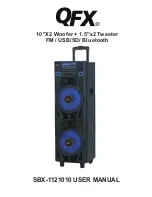
53
En
A
DDIT
IONA
L
INFORM
AT
ION
7
Engl
ish
AAC (Advanced Audio Coding)
An audio compression scheme defined as part of the
MPEG-2/MPEG-4 standard. AAC supports up to 48
channels and generally achieves better sound quality
than MP3 at the same bit rate.
Analog
Sound that has not been turned into numbers.
Analog sound varies, while digital sound has specific
numerical values. These terminals send audio through
two channels, the left and right.
Aspect ratio
The ratio of vertical and horizontal sizes of a displayed
image. The horizontal vs. vertical ratio of conventional
TVs. is 4:3, and that of wide-screens is 16:9.
Bit
Short for binary digit. Represents the smallest unit of
information manipulated on a computer. In audio
systems, the bit size determines resolution to digitize
analog signals.
The larger the bit size, the larger the dynamic range (the
ratio of maximum and minimum frequency level) and
the finer the sounds. Generally, an audio CD is 16 bit
and DVD audio is 24 bit.
Bit rate
The amount of data used to hold a given length of
music; measured in kilobits per second, or kbps. Also,
the speed at which you record. Generally, the higher the
bit rate, or recording speed, the better the sound quality.
However, higher bit rates use more space on a disc.
Component Video
Terminals for inputting or outputting a component video
signal.Component video signal consists of three lines,
the luminance signal (Y) and two color difference
signals (P
B
/C
B
, P
R
/C
R
), which enable to provide high-
quality video.
Disc menu
A screen display prepared for allowing selection of
images, sounds, subtitles, multi-angles, etc. recorded on
a DVD.
DivX
DivX
®
is a video compression technology developed by
DivX
®
Networks, Inc. It compresses digital video data to
sizes small enough to be transported over the Internet
without reducing the original video quality. You need
DivX codec software to play back DivX movies or
convert data to the DivX format.
Dolby Digital
Digital surround sound system which is developed by
Dolby Laboratories provides completely independent
multi-channel audio. With 3 front channels (left, center,
and right) and 2 surround stereo channels, Dolby Digital
provides five full-range audio channels. With an
additional channel especially for bass effects (called
LFE, or low frequency effect), the system has a total of
5.1-channels (LFE is counted as 0.1 channel). By using
2-channel stereo for the surround speakers, more
accurate moving sound effects and surround sound
environment are possible than with Dolby Surround.
Dolby Surround Pro Logic II
It is an improved matrix decoding technology that
provides better spatiality and directionality on Dolby
Surround programme material; provides a convincing
three-dimensional soundfield on conventional stereo
music recordings; and is ideally suited to bring the
surround experience to automotive sound. While
conventional surround programming is fully compatible
with Dolby Surround Pro Logic II decoders,
soundtracks will be able to be encoded specifically to
take full advantage of Pro Logic II playback, including
separate left and right surround channels. (Such material
is also compatible with conventional Pro Logic
decoders).
DTS (Digital Theater Systems)
Digital surround sound system developed by Digital
Theater Systems, Inc., which provides 5.1 channel audio
(max). With an abundance of audio data, it is able to
provide authentic-sounding effects.
HDMI
HDMI (High-Definition Multimedia Interface) is the
first industry-supported, uncompressed, all-digital
audio/video interface. Providing an interface between
any source (such as a set-top box or AV receiver) and
an audio/video monitor (such as a digital television),
HDMI supports standard, enhanced or high-definition
video as well as multi-channel digital audio using a
single cable. HDMI transmits all ATSC (Advanced
Television Systems Committee) HDTV standards and
supports 8-channel digital audio, with bandwidth to
spare to accommodate future enhancements and
requirements.
When used in combination with HDCP (High-
bandwidth Digital Content Protection), HDMI
provides a secure audio/video interface that meets the
security requirements of content providers and system
operators.
For further information on HDMI, visit the HDMI
website at “www.hdmi.org/”.
Interlace
The most common type of scanning used in televisions.
It divides a screen into even and odd numbered fields for
scanning, and then builds an image by combining them
Glossary
Содержание DVR-1000
Страница 61: ...59 En English ...
Страница 121: ...59 Fr Français ...
Страница 181: ...59 De Deutsch ...
Страница 241: ...59 Sv Svenska ...
Страница 301: ...59 It Italiano ...
Страница 361: ...59 Es Español ...
Страница 421: ...59 Nl Nederlands ...
















































